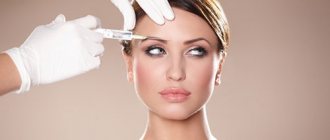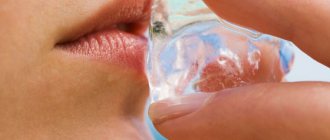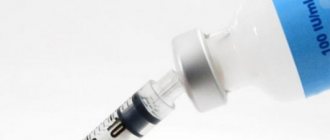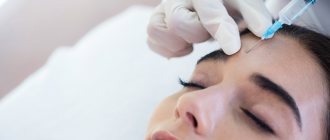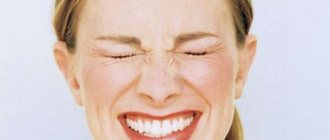Botox: what is it, features
Botox is an injectable solution based on botulinum toxin, the strongest neurotoxin in nature. In cosmetology and medicine, it is used in diluted form, which does not pose a threat to humans. The principle of Botox is to block the signal from the brain to the muscles. As a result, they stop working.
In medicine, it is used to treat cerebral palsy, epilepsy, chronic migraine, strabismus, muscle spasms and other neurological diseases.
In the 1970s, scientists, noticing the muscle-paralyzing effect, began conducting tests on patients with strabismus. During the experiments, they discovered another interesting effect - the disappearance of facial wrinkles at the injection sites. It turned out that botulinum toxin injections do not harm health, so they began to use it in cosmetology. This is how botulinum therapy appeared.
Botulinum toxin-based substances have different commercial names that are identical to the names of the drugs:
- Botox;
- Botulax;
- Dysport;
- Relatox;
- Xeomin.
Injections are made into areas of the body (directly into the muscles) where the most wrinkles form. All this is done with local anesthesia and does not take much time. After a maximum of 10 days, the drug begins to take full effect. At this time, a person’s facial expressions may be impaired due to paralysis of muscle fibers.
The effect lasts from 3 to 8 months, but on average six months. A lot depends on individual characteristics. After this period, the ability to express one’s emotions through facial expressions gradually returns. But often a habit of doing without it develops.
Who can use Botox and who can't?
Indications for botulinum therapy:
- facial wrinkles on the forehead, bridge of the nose;
- nasolabial folds (it is advisable to use fillers in addition);
- the need to correct the oval of the face;
- photoaging;
- age-related changes;
- hyperhidrosis (increased sweating);
- the need to change the shape of the nose (Botox can visually narrow the nose).
Contraindications to the procedure:
- antimicrobial therapy;
- oncology;
- pregnancy or lactation period;
- poor eyesight;
- asthenia (muscle weakness);
- menstruation;
- poor blood clotting;
- herpes in acute form;
- calcium intake.
Before the procedure, it is necessary to inform the doctor about all your diseases so that he takes this into account. If there is a tendency to bags under the eyes or swelling of the face, you should also tell your doctor about this.
Video: What is Botox and what wrinkles does it eliminate?
Fillers: the benefits of injections
Fillers are the second most popular option for injectable appearance corrector. The most popular base substance: hyaluronic acid of non-animal origin. The animal version is highly allergenic. The composition of the filler can also be based on:
- collagen;
- poly-L-lactic acid;
- calcium hydroxyapatite;
- polymers.
It is preferable to use substances from biodegradable materials. This will give a more predictable result with minimal possibility of complications.
Fillers are used to correct appearance, changes in which are associated with deformation of contours and lack of tissue volume. The option allows:
- regulate the fullness of certain areas;
- shape, tighten an oval;
- improve skin quality;
- stimulate internal rejuvenation;
- minimize wrinkles.
Filler is used to fill specified areas. This helps push wrinkles out of the depths, lift sagging areas, eliminate “bruises” and sunken areas. The filler is designed to last for 6–18 months. Gradually, the donor volume is absorbed, and the problems return.
It is recommended to choose filler as a means of injection correction for those who have dry, sagging skin, gravitational ptosis, lack of tissue volume, and wrinkles formed by tissue sagging.
Indications and principle of action
Both injection techniques are aimed at rejuvenating the skin, but they do it in different ways. Fillers are aimed at eliminating the cause of age-related changes, since they fill the folds with components that are produced in the human body, but do it too slowly.
Botox only affects the effects of skin aging. The drug rejuvenates the face only visually, creating the illusion of healthy smoothness. Fillers act from the inside, so they provide real benefits.
Indications for the use of Botox in cosmetology are only facial wrinkles, and of any depth. The drug does not affect complexion or the consequences of dermatological problems. The most effective injections are in the upper third - in the forehead and between the eyebrows.
The range of application of fillers is wider. They are used for the following purposes:
- increasing skin elasticity, eliminating turgor;
- eliminating bags and dark circles under the eyes;
- softening pronounced nasolabial folds;
- eliminating wrinkles, filling other cavities;
- increasing the chin, adding volume to the lips, changing the shape of the nose, cheekbones;
- treatment of stretch marks, scars, including acne;
- correction of facial asymmetry.
Fillers do not act as pronouncedly as Botox, but they work in several directions at once in a complex. The products can be used on all areas of the face - the procedure will be equally effective everywhere.
Course duration
The advantage of botulinum therapy is that only 1 session is needed. It only takes 15-20 minutes. Because of this, Botox injections are also called a lunchtime procedure - you can go to a cosmetologist, and then continue to do your usual activities, including going to work.
The course of filler injection lasts longer. The number of sessions is determined by the cosmetologist. On average, it is recommended to do 3 procedures with an interval of 15-20 days. Then the result is consolidated with single sessions every 3-4 months. After completing the latter, take a break until the effect begins to wear off. Each session takes 35-40 minutes.
❤
Advantages and disadvantages of Botox
Among the advantages of botulinum therapy are the following:
- fast completion of the procedure;
- painlessness;
- quick effect;
- the frequency of repetition of the procedure is no more than once every 3 months;
- prevention of deep wrinkles;
- lack of rehabilitation period.
If the procedure is carried out in compliance with all necessary antiseptic and sanitary requirements, and a qualified cosmetologist administers Botox, then serious complications and negative consequences can be avoided. Otherwise, you may encounter the following negative consequences:
- distortion of facial expressions;
- pronounced swelling of the face;
- paralysis of the muscles around the mouth;
- shorter-term effect in athletes;
- drooping of the eyebrows, eyelids and corners of the lips;
- mask effect on the face;
- inability to blink normally, chew food and swallow.
To avoid most undesirable consequences, you need to choose a doctor with a higher specialized education and extensive experience working with Botox.
Should I choose Botox or fillers?
Botox is useful for those who want to get rid of fine lines, crow's feet and deep wrinkles around the mouth, and Botox is also used to combat hyperhidrosis.
Dermal fillers are an effective means of removing wrinkles, age-related folds, and adding volume to the face.
There are no known risks associated with Botox or dermal filler injections for women who are pregnant or breastfeeding, but the procedure is not recommended during this period.
Filler: what is it, features
Fillers are drugs that are used to fill voids or wrinkles. They are used to obtain a lifting effect and correct facial contours. The procedure is called filling and is used for:
- smoothing nasolabial folds, filling lips and filling deep wrinkles;
- correction of cheeks and cheekbones;
- correction of facial asymmetry;
- adjustments to the shape of the ears;
- correction of the buttocks, arms or décolleté.
The filler is usually hyaluronic acid (a natural component of the intercellular matrix), collagen, and the patient’s own adipose tissue. The filler has a dense gel consistency.
During the procedure, the doctor applies a creamy local anesthetic to the area of skin being treated. Simultaneously with the slow introduction of the filler, the cosmetologist distributes it with light pressure on the skin. The effect becomes noticeable immediately - the wrinkle disappears. The doctor imitates the patient's facial expressions with his hands to check how the muscle and skin behave. If new wrinkles form at the same time, the doctor injects the drug there as a preventive measure.
After the procedure, redness and swelling may appear at the injection sites. This is the body's natural reaction to stress and skin damage. In a few days everything will pass.
Over time, the gel dissolves in the dermis and the effect disappears.
Fillers that are in greatest demand:
- Restilain Perline;
- Lal system;
- Belotero;
- Princess Volume;
- Teosyal;
- Juviderm.
The effect of fillers is longer lasting than the effect of Botox - from 6 months to a year.
The duration of action of fillers depends on:
- patient's age;
- lifestyle;
- exposure to sunlight;
- use of a bathhouse, sauna;
- use of certain medications;
- diet.
The procedure has the following contraindications:
- hypersensitivity to any of the components, including allergic reactions to anesthetics;
- pregnancy;
- lactation period;
- acute inflammatory processes in the body, including autoimmune ones.
After the procedure, the face looks renewed and rejuvenated. Wrinkles are smoothed out, the face glows with freshness.
What is the difference between fillers and Botox?
The botulinum toxin substance and the gel filler have a number of functional differences - the speed of manifestation of the result (after Botox it is visible in a month, and after fillers - in 2-3 weeks), the cost of the procedure (and it will differ significantly depending on the chosen product based on hyaluronic acid), effectiveness depends on the specific wishes of the client.
Advantages and disadvantages of filler
Advantages of fillers:
- do not cause pigmentation, so the procedure can be performed at any time of the year;
- stimulate the skin's production of its own collagen and activate metabolic processes in the dermis, improving skin quality;
- Repeated injection of fillers can correct the errors of the previous procedure.
Disadvantages and possible side effects of fillers:
- tissue necrosis;
- granuloma;
- painful procedure;
- swelling and redness due to a vessel clogged with gel;
- the appearance of edema due to anesthesia;
- rehabilitation period up to 14 days;
- unnaturalness of the face or its parts when administering excessive doses of the drug;
- possible rejection by the body of the filler as a foreign body;
- allergic reactions;
- the development of tissue fibrosis and the formation of scars when moving synthetic filler (although these have not been used widely for a long time);
- development of benign neoplasms;
Even a certified specialist cannot guarantee the absence of side effects. Therefore, you need to take the procedure seriously, carefully considering your decision.
Features of the administration of botulinum toxin and fillers - indications and side effects
There is no recovery period after botulinum toxin injection, but it is important to remember that there may be slight swelling at the puncture site immediately after the procedure and sometimes slight bruising may appear.
Otherwise, the patient can return to normal life after the procedure. Botulinum toxin injections are suitable for patients who want to get rid of wrinkles. Botulinum toxin is injected into the muscles to relax them and smooth out facial wrinkles.
To avoid complications after botulinum toxin injection, you must notify your doctor about any existing nerve or muscle damage, skin diseases or other chronic diseases. Botulinum toxin is contraindicated in pregnant and lactating women.
As for fillers, the injection procedure takes 30-45 minutes, and during the procedure, small bruises or swelling may appear in the area of the injection point. As a rule, such symptoms disappear within a day or two, and the patient can return to normal life immediately after the injection of fillers.
The introduction of fillers is indicated for those wishing to smooth out wrinkles, correct the oval of the face and add volume in certain areas.
Fillers, like botulinum toxin, are contraindicated for pregnant and lactating women, as well as in cases of exacerbation of chronic diseases and inflammation of the skin at the injection site.
Thus, when choosing botulinum toxin or fillers, you need to contact an experienced doctor who will explain which procedures will be most effective for smoothing wrinkles and rejuvenating the face in a particular case, and also describe in detail all the risks, restrictions and recommendations for skin care after the procedures.
To understand a little about the best aesthetic procedures, today we’ll talk about the two most popular ones, such as Botox and fillers. Which one is better and what the fundamental difference is, we will find out below.
What is the difference between Botox and filler
Filler and Botox have different purposes. The first fills wrinkles and voids, adds volume, and the second paralyzes groups of facial muscles.
Botox does not produce a visible effect immediately, unlike fillers, the effect of which can be seen instantly.
Filling the necessary areas with fillers is a painful procedure. Botox, on the other hand, does not cause any pain.
The main differences between fillers and Botox:
- different principles of operation;
- Botox does not change the skin, but fillers do, giving it volume and improving its properties;
- the composition of the injections is radically different, as described in detail above;
- Botox is used most often in the upper part of the face, and fillers are used in any part of the face, and also on other parts of the body;
- Botox does not have a recovery period; for fillers it is about two weeks;
- Botox has more contraindications and more serious side effects that are difficult to eliminate;
- price - Botox is cheaper than fillers.
How does the procedure work?
Like Botox, dermal fillers are injected into the skin using a very fine needle. Botox has no long-term side effects, and patients can resume normal activities immediately after the procedure. The procedure itself takes only a few minutes and is painless.
Dermal filler injections are done using Juvederm, Restylane, Radiesse, etc. Treatment takes approximately 30 to 45 minutes. After the procedure, minor bruising and swelling is possible, which will decrease within a few hours.
Fillers, Botox, biorevitalization – trying something new
02.07.2020
About once a year I go to a cosmetologist not for a regular facial massage or other little things, but “under the needle.” For many it sounds scary, but for me, after I’ve been successfully practicing this for ten years, it’s not at all. This time I didn’t go to my usual cosmetologist, but to the Petrovka-beauty clinic, where I took a laser hair removal course (with success that I didn’t even hope for - now I epilate about once every year and a half, and that’s some a measly five or six hairs).
In all cases of injections in the face, I put myself in the hands of a specialist: if the cosmetologist thinks that this and that are unnecessary, then I will not insist. If he recommends just such a drug, and not that, then I also don’t feel competent enough to argue. But for this approach, you understand, you need a proven good master, and I signed up with Marina Izrailova, whose work I usually really like.
I specially applied a stylized filter to the photo so as not to scare those who don’t like to look at the syringe! I hope I didn't hurt anyone.
So what did we decide to do? Well, firstly, after the autumn SMAS lifting it turned out that there was no need to correct the oval of the face and the line of the lower jaw. I inject Botox into my forehead about once every two years: so rarely, because after the procedure I get used to not wincing and I can easily get by with courses of drugs with muscle relaxants. To prevent nasolabial folds from forming, I inject fillers there; Well, and biorevitalization for the entire face and neck.
Something new has been added here. Firstly, Marina suggested that I add fillers to my lips. I really don’t want to pump them up, and indeed change my appearance - just remove age-related “fatigue”; but Marina explained that we would only slightly correct their reduction and make the contour clearer: over time, we all get thinner lips, and the contour suffers.
Secondly, instead of the usual Restylane, we decided to inject Novacutan (specifically Novacutan Ybio) into the face. What is its difference from the usual means for biorevitalization: firstly, it is injected through a cannula into each half of the face, and there is no need for dozens of small injections. But this is not its only advantage: Novacutan Ybio is also an exoprotector, that is, it protects skin cells from negative effects (ultraviolet radiation, exhaust gases, computer radiation, etc.).
And thirdly, a new drug also went into the neck: Profhilo. This is also a drug based on hyaluronic acid, but with a more interesting effect: it provides reinforcement (that is, resistance to sagging), lifting, and stimulates blood circulation. Marina strongly recommended it for the neck, and I decided to try it.
So, there was a lot of new and unusual things! We started with fillers.
I once told you that for me, in addition to a cosmetologist’s qualifications, his ability to communicate with a client is extremely important. So, I noticed a very cool (albeit not entirely obvious) point that Marina adhered to when working with me. You know how some people save the best for last? That is, they eat what they like least first, and their favorite food later. So, in matters of unpleasant effects (such as injections, which even with minimal pain still cannot be classified as pleasures), a similar rule works: it is better to do the most unpleasant thing first. And when the client pays off, you can tell him with a clear conscience: “That’s it, now it will only be easier.”
For example, one half of my face needs more influence - simply because I almost always sleep on the same side; yeah, I know that this is not good, that in general “sleeping on your face” means creating folds and creases, but what can I do if it’s comfortable for me this way, but not the other way! So, Marina began the correction from this half, and the most unpleasant of the entire procedure was the introduction of Juvederm Voluma through a cannula (I told you what it is, here) along the jaw line. To be honest, I felt unwell not because of the pain - the cannula moves gently - but because I felt the movement of a foreign body under the skin. I felt unwell psychologically, I even asked for ammonia (coward, yes). By the way, I used Juvederm Voluma with lidocaine, so there was no pain at all.
But on the second half of the face, less of the drug was injected, the cannula did not move so far, and as a result, I was already prepared to suffer, but then - oops! And they took everything out. “How, is everything already?” — I asked, not believing my luck. "All!" - answered Marina.
She did the same with Botox: first she pierced the space between the eyebrows, where more units go, and then the rest of the forehead. I only now understand that this is a reasonable approach that makes the procedure more comfortable - and I really appreciate that they made my life so much easier.
I have some thoughts about Botox, which I have been injecting myself with for several years now. There are a lot of horror stories on the Internet about “paralyzing poison” - although, in fact, initially botulinum toxin, on the contrary, was developed to treat some mild cases of paralysis and spasms of various origins. And the myth that is especially persistent is that under the influence of Botox your facial muscles will finally “relax, become lazy and stop working,” after which your face will instantly drain into your pants, of course.
Well, firstly, I can simply refer to my experience - I have been injecting Botox for six years now, and my face has not weakened or sagged anywhere. Moreover, after six months with Botox, I for a long time wean myself from frowning and wrinkling my forehead, so it usually takes more than a year and a half before the next injection - I simply no longer need artificial fixation!
Well, secondly, I am very surprised by the logic of those who believe that “the face will become lazy.” That is, it is proposed to wrinkle and frown intensely so that the muscles work constantly and often? Is it okay that your face will be covered with a web of facial wrinkles and not at all pump up some important muscles? No, I’d rather restrain unwanted facial expressions with “paralyzing poison” - although I won’t dissuade adherents of cucumbers in the eyes and strawberries on the cheeks, everyone has their own path, seriously.
Injecting filler into my lips was not at all as painful as I thought: maybe it was due to the small volumes and, accordingly, the short impact. Here we used Juvederm Ultra Smile, this is a filler for fine jewelry correction, and not for pillow lips.
Novacutan Ybio, although it involves very few injections, when administered, it has an unpleasant side effect - it seems to sting under the skin. But this only works during the administration of the drug, that is, seconds. But after such biorevitalization, you can go to people on the same day, since the marks from the injections are very small and there are few of them. There is no trace of that effect of “a bunch of mosquito bites” as after Restylane. The result of the injections is not immediately visible - this is the effect of rested skin, which is clearly visible to a person who looks at himself in the mirror every day, but outsiders are unlikely to raise questions: “What did you do to yourself?”
And the last thing - Profile in the neck. It also doesn’t inject as much as Restylane, 9-10 injections, but at first it looks simply creepy: as if you were bitten by a flock of rabid bees. Like this:
How long this will take is a matter of your individual recovery, of course, but just in case, I would not recommend planning an exit with an open neck on the same day. I did it in February, so the scarf solved all my problems, and the next day there were only microscopic dots left from the injections.
But the effect is such that I will definitely repeat Profhilo every year! The folds and wrinkles on my neck smoothed out, as if from a Photoshop filter, and I’m sure I haven’t seen my neck in such great condition for three years.
We did fillers and Botox once, as usual, and Novacutan and Profhilo - twice, with an interval of three weeks. Is the result worth all this trouble? In my opinion, it's definitely worth it!
Yes, there is not such a spectacular contrast in the “before” and “after”, as they like to show on clinic websites - but I just regularly do maintenance procedures, and I also bother with daily care, so for now I don’t have that same “before” look deplorable. I am very pleased in the end and plan to stick to this injection plan in the near future. I like exactly this light refreshment plus care at the cellular level; I don’t want to get a new face or “minus 10 years”.
How do you feel about injections? What have you tried, what are you planning to try?
Similarities
Both fillers and Botox are solutions for injections. Even taking into account the fact that the injections are made to different depths, there are the same contraindications to the procedure. The techniques can negatively affect some conditions and aggravate the course of diseases. The restrictions on injection rejuvenation procedures are as follows:
- pregnancy and lactation;
- infectious diseases;
- malignant tumors;
- hypersensitivity of the immune system, allergy to the components of the product;
- hemophilia;
- diabetes;
- epilepsy;
- tendency to form keloid scars;
- facial surgeries performed within 6 months;
- a course of taking antibiotics, hormones and drugs that affect blood clotting;
- alcohol addiction;
- exacerbation of herpes;
- recovery period after illness;
- unhealed lesions, inflammation, moles, papillomas and other formations in the area of influence.
Botox has several additional contraindications. It should not be injected for diseases of the nervous or muscular system, for kidney pathologies, or for fatty hernias on the face.
Among the similarities between the two methods is the permissible age for the procedure. Botox can be injected for cosmetic purposes from the age of 18. Cosmetologists recommend starting a course of botulinum therapy at 25-30 years of age. The same framework is established for fillers.
Only a trained cosmetologist can perform both procedures. The clinic must have a license for rejuvenation services. You cannot inject Botox or fillers at home. Even if a person has the necessary education, he will not be able to create conditions of complete sterility in the room. There is a risk of contracting an infection.
Preparation for the procedure
The cosmetologist who will administer the fillers will definitely advise you on the specifics of the preparation. Primary requirements:
- two weeks before the procedure, stop using scrubs and chemical peels;
- protect the skin from the sun, since fillers should not be injected when the tan is fresh;
- three days before the procedure, do not drink alcohol, antibiotics or anticoagulants.
On the day of the procedure, you should refrain from using skincare and decorative cosmetics.
Contraindications for use
While fillers are mostly based on natural skin components, Botox is a drug that changes the natural mechanics of the human body. It cannot be used in the following cases:
- Individual intolerance to components.
- Inflammatory processes and skin diseases at the injection site.
- Use of antibiotics and other medications with associated contraindications.
- Chronic diseases that weaken the immune system.
- Pregnancy, lactation, hemophilia, myopia.
- Endocrine diseases.
- High tendency to form scars.
Botox
Botox is very popular because it allows not only to correct facial wrinkles, but also to correct the facial habits that caused them. The main component of this cosmetic drug is botulinum toxin type A. When it enters a muscle, the drug blocks the possibility of transmitting nerve impulses to muscle tissue.
Within a week after the injection, the product permeates the muscle tissue, and the facial muscle stops moving and responding to commands from the brain. The effect lasts about 6 months, after which the muscle returns to its previous state. Firstly, after 6 months without movement, the skin naturally smoothes out, and secondly, a person cannot frown in his usual way, due to which the bad facial habit disappears.
To get rid of a bad habit forever, cosmetologists recommend repeating the procedure after a while. You must be very careful when choosing a specialist, because an incorrect injection can cause strabismus, nervous tics and a huge list of other disorders
In addition to facial correction, Botox is used to solve the problem of excessive sweating, because it blocks the work of muscles that cause overheating and natural cooling by releasing moisture.

